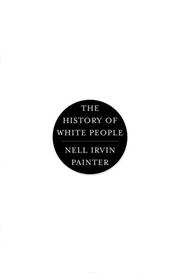| Listing 1 - 10 of 37 | << page >> |
Sort by
|
Book
ISBN: 9780670785971 9781101608487 0670785970 Year: 2016 Publisher: New York, N.Y. Viking
Abstract | Keywords | Export | Availability | Bookmark
 Loading...
Loading...Choose an application
- Reference Manager
- EndNote
- RefWorks (Direct export to RefWorks)
"A history of the class system in America from the colonial era to the present illuminates the crucial legacy of the underprivileged white demographic, citing the pivotal contributions of lower-class white workers in wartime, social policy, and the rise of the Republican Party,"--NoveList.
History of North America --- United States --- Social classes --- Poor whites --- Working class whites --- History. --- Social conditions --- United States of America
Multi
ISBN: 9780807047415 9780807047422 Year: 2018 Publisher: Boston Beacon Press
Abstract | Keywords | Export | Availability | Bookmark
 Loading...
Loading...Choose an application
- Reference Manager
- EndNote
- RefWorks (Direct export to RefWorks)
"In this groundbreaking and timely book, antiracist educator Robin DiAngelo deftly illuminates the phenomenon of white fragility. Referring to the defensive moves that white people make when challenged racially, white fragility is characterized by emotions such as anger, fear, and guilt, and by behaviors including argumentation and silence. These behaviors, in turn, function to reinstate white racial equilibrium and prevent any meaningful cross-racial dialogue. In this in-depth exploration, DiAngelo explores how white fragility develops, how it protects racial inequality, and what we can do to engage more constructively."--Back cover.
Social problems --- sociale psychologie --- racisme --- vooroordelen --- Racism --- Whites --- Race relations --- European Continental Ancestry Group --- Race Relations
Multi
ISBN: 9781447335979 144733597X 9781447335993 9781447336006 9781447335986 1447336003 1447335988 1447335996 Year: 2018 Publisher: Bristol Policy Press
Abstract | Keywords | Export | Availability | Bookmark
 Loading...
Loading...Choose an application
- Reference Manager
- EndNote
- RefWorks (Direct export to RefWorks)
Why and how do those from black and minority ethnic communities continue to be marginalised? Despite claims that we now live in a post-racial society, race continues to disadvantage those from black and minority ethnic backgrounds. Kalwant Bhopal explores how neoliberal policy making has increased rather than decreased discrimination faced by those from non-white backgrounds. She also shows how certain types of whiteness are not privileged; Gypsies and Travellers, for example, remain marginalised and disadvantaged in society. Drawing on topical debates and supported by empirical data, this important book examines the impact of race on wider issues of inequality and difference in society
Minorities --- Post-racialism. --- Privilege (Social psychology). --- Social conditions. --- arbeidsmarkt --- scholing --- armoede --- gender --- racisme --- Sociology of minorities --- Whites --- Race identity --- Equality --- Post-racialism --- Privilege (Social psychology) --- Social conditions --- History --- Attitudes --- United States --- Great Britain --- Race relations --- Discriminatie --- Etnisch-culturele minderheden --- Neoliberalisme --- Sociale ongelijkheid --- Race discrimination --- Social problems --- White people --- Whites - United States - Social conditions --- Whites - Great Britain - Social conditions --- Whites - Race identity - United States - History --- Whites - Race identity - Great Britain - History --- Whites - United States - Attitudes - History --- Whites - Great Britain - Attitudes - History --- Equality - United States --- Minorities - Social conditions --- United States - Race relations --- Great Britain - Race relations --- History. --- Race relations. --- White persons --- Ethnology --- Caucasian race

ISBN: 0415095379 9780415095372 Year: 1997 Publisher: London Routledge
Abstract | Keywords | Export | Availability | Bookmark
 Loading...
Loading...Choose an application
- Reference Manager
- EndNote
- RefWorks (Direct export to RefWorks)
White people are not literally or symbolically white; nor are they uniquely virtuous and pure. Racial imagery and racial representation are central to the organisation of the contemporary world but, while there are many studies of images of black and Asian people, whiteness is an invisible racial position. At the level of racial representation, whites are not of a certain race. They are just the human race, a 'colour' against which other ethnicities are always examined. In White , Richard Dyer looks beyond the apparent unremarkability of whiteness and argues for the importance of analysing images of white people. Dyer traces the representation of whiteness by whites in Western visual culture, focusing on the mass media of photography, advertising, fine art, cinema and television. Dyer examines the representation of whiteness and the white body in the contexts of Christianity, 'race' and colonialism and, in a series of absorbing case studies, he discusses the representations of whiteness in muscle-man action cinema, from Italian 'peplum' movies to the Tarzan and Rambo series; shows the construction of whiteness in photography and cinema in the lighting of white and black faces, and analyses the representation of white women in end-of-empire fictions such as The Jewel in the Crown , and traces the disturbing association of whiteness with death, in vampire narratives and dystopian films such as Blade Runner and the Aliens trilogy.
Sociology of culture --- 82.091 --- #SBIB:309H504 --- Vergelijkende literatuurstudie --- Code en boodschap: sociologische, antropologische benadering --- Whites in popular culture. --- 82.091 Vergelijkende literatuurstudie --- Whites in popular culture --- Popular culture --- Blancs --- Médias et culture --- Groupe ethnique --- Dans l'art
Book
ISBN: 9782246826439 2246826438 Year: 2020 Publisher: Paris Bernard Grasset
Abstract | Keywords | Export | Availability | Bookmark
 Loading...
Loading...Choose an application
- Reference Manager
- EndNote
- RefWorks (Direct export to RefWorks)
Male domination (Social structure) --- Whites --- Anti-imperialist movements --- Communalism --- Race identity --- Political philosophy. Social philosophy --- Male domination (Social structure) - France --- Whites - Race identity - France --- Anti-imperialist movements - France --- Communalism - France

ISBN: 9780393339741 0393339742 9780393049343 Year: 2011 Publisher: New York Norton
Abstract | Keywords | Export | Availability | Bookmark
 Loading...
Loading...Choose an application
- Reference Manager
- EndNote
- RefWorks (Direct export to RefWorks)
Traces the idea of a white race, showing how the origins of the American identity were tied to the elevation of white skin as the embodiment of beauty, power, and intelligence, and how even intellectuals insisted that only Anglo Saxons were truly American.
Whites --- History. --- Race identity --- United States --- Race relations. --- White people --- White persons --- History --- Race question --- Ethnology --- Caucasian race --- World history
Book
ISBN: 2763746543 9782763746548 9782763746531 2763746535 Year: 2019 Publisher: [Quebec, Que.] Presses de l'université Laval
Abstract | Keywords | Export | Availability | Bookmark
 Loading...
Loading...Choose an application
- Reference Manager
- EndNote
- RefWorks (Direct export to RefWorks)
Ce recueil de portraits jette un regard neuf sur le rôle joué par une quinzaine d’interprètes dans la trame culturelle, politique et commerciale du Canada, le « pays du castor ». Il nous fait voyager de l’Atlantique aux Rocheuses et de l’Iroquoisie à l’Arctique. Les hommes et les femmes qui le composent appartiennent à cinq catégories d’interprètes : le compagnon des explorateurs, le collaborateur des autorités civiles, l’officier militaire, l’aide-missionnaire et le trafiquant ou l’émissaire de compagnies de fourrures. En tant qu’acteurs clés des contacts entre Autochtones, Blancs et Inuits, les interprètes occupent une place importante, pourtant méconnue, sur le grand échiquier de l’histoire canadienne. Suivre leur parcours, c’est découvrir des facettes insoupçonnées du métier de ces personnages, qui sont aussi agents commerciaux, chasseurs, conseillers, diplomates, éclaireurs, guides, négociateurs de traités ou pacificateurs. Richement contextualisée et illustrée, chaque esquisse biographique fait ressortir les conditions d’exercice du métier, tout en apportant des éléments de réponse à de nombreuses questions : dans quelles circonstances les interprètes ont-ils appris les langues? Quelles pratiques et coutumes autochtones doivent-ils connaître pour éviter les impairs? À quels rites de passage sont-ils soumis? Quels risques courent-ils dans les milieux parfois hostiles qu’ils fréquentent? Quelles relations entretiennent-ils avec les autorités civiles? Les militaires? Les explorateurs ? Les missionnaires? Les femmes autochtones? À quel camp accordent-ils leur loyauté? Les interprètes que ces pages font revivre ont en commun d’avoir connu un destin exceptionnel. Plusieurs d’entre eux ont mérité le titre de « personne d’importance historique nationale », décerné par le gouvernement canadien. Interprètes au pays du castor fait suite aux collectifs Portraits de traducteurs (1998) et Portraits de traductrices (2002).
Fur trade --- History. --- Indian interpreters --- Indians of North America --- Translators --- Whites --- Canada --- Interpreting --- anno 1600-1699 --- anno 1800-1999

ISBN: 0195132793 Year: 2000 Publisher: New York Oxford University Press
Abstract | Keywords | Export | Availability | Bookmark
 Loading...
Loading...Choose an application
- Reference Manager
- EndNote
- RefWorks (Direct export to RefWorks)
African Americans --- Race awareness --- Whites in literature --- Whites --- European Americans --- Awareness --- Ethnopsychology --- Ethnic attitudes --- Afro-Americans --- Black Americans --- Colored people (United States) --- Negroes --- Africans --- Ethnology --- Blacks --- Attitudes --- History --- Intellectual life --- United States --- Race relations. --- Race question --- Sociology of minorities --- History of North America --- anno 1800-1999 --- Black people --- White persons --- Caucasian race --- United States of America
Book
ISBN: 9780739124826 9780739133897 0739133896 9781461633426 1461633427 073912482X 9780739124895 0739124897 9780739131404 0739131400 9781461633433 1461633435 1283616998 9781283616997 9780739124888 0739124889 9786613929440 9786613929457 1283617005 Year: 2010 Publisher: Lanham, Md Lexington
Abstract | Keywords | Export | Availability | Bookmark
 Loading...
Loading...Choose an application
- Reference Manager
- EndNote
- RefWorks (Direct export to RefWorks)
The contributors to this volume explore the themes of fear, cultural anxiety, and transformation as expressed in remade horror, science fiction, and fantasy films. While opening on a note that emphasizes the compulsion of filmmakers to revisit issues concerning fear and anxiety, this collection ends with a suggestion that repeated confrontation with these issues allows the opportunity for creative and positive transformation.
Sociology of the family. Sociology of sexuality --- Film --- Horror films --- Science fiction films --- Fantasy films --- Film remakes --- Motion picture remakes --- Motion pictures --- Moving-picture remakes --- Remakes, Film --- History and criticism. --- Remakes --- Masculinity in motion pictures. --- Heterosexual men in motion pictures. --- Whites in motion pictures. --- Whites in motion pictures --- White people in motion pictures.
Book
ISBN: 9781433131103 1433131102 9781453918487 9781433137785 Year: 2016 Publisher: New York Peter Lang
Abstract | Keywords | Export | Availability | Bookmark
 Loading...
Loading...Choose an application
- Reference Manager
- EndNote
- RefWorks (Direct export to RefWorks)
What does it mean to be white in a society that proclaims race meaningless, yet is deeply divided by race? In the face of pervasive racial inequality and segregation, most white people cannot answer that question. In the 2nd edition of this seminal text, Dr. DiAngelo reveals the factors that make this question so difficult: mis-education about what racism is; ideologies such as individualism and colorblindness; segregation; and the belief that to be complicit in racism is to be an immoral person. These factors contribute to what she terms white racial illiteracy. Speaking as a white person to other white people, DiAngelo clearly and compellingly takes readers through an analysis of white socialization. Weaving research, analysis, stories, images, and familiar examples, she provides the framework needed to develop white racial literacy. She describes how race shapes the lives of white people, explains what makes racism so hard to see, identifies common white racial patterns, and speaks back to popular narratives that work to deny racism. Written as an accessible overview on white identity from an anti-racist framework, What Does It Mean to Be White? is an invaluable resource for members of diversity and anti-racism programs and study groups, and students of sociology, psychology, education, and other disciplines. --Amazon.com
Whites --- Race relations. --- Racism. --- Race identity. --- Bias, Racial --- Race bias --- Race prejudice --- Racial bias --- Prejudices --- Anti-racism --- Race relations --- Integration, Racial --- Race problems --- Race question --- Relations, Race --- Ethnology --- Social problems --- Sociology --- Ethnic relations --- Minorities --- Racism --- Race identity of whites --- Racial identity of whites --- Whiteness (Race identity) --- Race awareness --- Ethnic identity --- Racisme --- Relations interethniques --- Blancs --- Identité collective --- #SBIB:309H504 --- #SBIB:39A6 --- Code en boodschap: sociologische, antropologische benadering --- Etniciteit / Migratiebeleid en -problemen --- Relations raciales --- Identité ethnique --- Race identity --- Identité ethnique --- Racisme. --- Relations interethniques. --- Identité collective. --- Sociology of minorities --- Critical race theory --- Race identity of white people --- Racial identity of white people --- White people --- White persons --- Caucasian race --- Identité collective.
| Listing 1 - 10 of 37 | << page >> |
Sort by
|

 Search
Search Feedback
Feedback About UniCat
About UniCat  Help
Help News
News